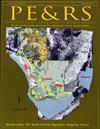基于SynthCity数据训练的深度学习在城市点云分类中的有效性
IF 2
4区 地球科学
Q4 GEOGRAPHY, PHYSICAL
引用次数: 0
摘要
三维物体识别是计算机视觉中最热门的研究领域之一。许多最新的算法专注于室内点云、3D几何物体分类和室外3D场景分割。分类管道的挑战之一是找到足够和准确的训练数据。因此,本文试图评估名为SynthCity的合成生成数据集的准确性,并在两个移动激光扫描数据集上进行测试。对训练数据施加不同程度的噪声,以反映不同扫描仪中不同程度的噪声。选择的深度学习算法是核点卷积,这是一种卷积神经网络,使用欧几里得空间中的核点作为卷积权值。本文章由计算机程序翻译,如有差异,请以英文原文为准。
Effectiveness of Deep Learning Trained on SynthCity Data for Urban Point-Cloud Classification
3D object recognition is one of the most popular areas of study in computer vision. Many of the more recent algorithms focus on indoor point clouds, classifying 3D geometric objects, and segmenting outdoor 3D scenes. One of the challenges of the classification pipeline is finding adequate
and accurate training data. Hence, this article seeks to evaluate the accuracy of a synthetically generated data set called SynthCity, tested on two mobile laser-scan data sets. Varying levels of noise were applied to the training data to reflect varying levels of noise in different scanners.
The chosen deep-learning algorithm was Kernel Point Convolution, a convolutional neural network that uses kernel points in Euclidean space for convolution weights.
求助全文
通过发布文献求助,成功后即可免费获取论文全文。
去求助
来源期刊

Photogrammetric Engineering and Remote Sensing
地学-成像科学与照相技术
CiteScore
1.70
自引率
15.40%
发文量
89
审稿时长
9 months
期刊介绍:
Photogrammetric Engineering & Remote Sensing commonly referred to as PE&RS, is the official journal of imaging and geospatial information science and technology. Included in the journal on a regular basis are highlight articles such as the popular columns “Grids & Datums” and “Mapping Matters” and peer reviewed technical papers.
We publish thousands of documents, reports, codes, and informational articles in and about the industries relating to Geospatial Sciences, Remote Sensing, Photogrammetry and other imaging sciences.
 求助内容:
求助内容: 应助结果提醒方式:
应助结果提醒方式:


